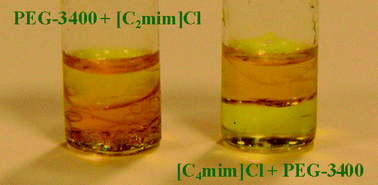Biphasic liquid mixtures of ionic liquids and polyethylene glycols†
Abstract
We have found that 1-alkyl-3-methylimidazolium chloride

* Corresponding authors
a QUILL, School of Chemistry and Chemical Engineering, The Queen’s University of Belfast, Belfast, UK
b
Center for Green Manufacturing and Department of Chemistry, The University of Alabama, Tuscaloosa, USA
E-mail:
rdrogers@as.ua.edu
Fax: +1 205-348-0823
Tel: +1 205-308-4323
We have found that 1-alkyl-3-methylimidazolium chloride

 Please wait while we load your content...
Something went wrong. Try again?
Please wait while we load your content...
Something went wrong. Try again?
H. Rodríguez, M. Francisco, M. Rahman, N. Sun and R. D. Rogers, Phys. Chem. Chem. Phys., 2009, 11, 10916 DOI: 10.1039/B916990C
To request permission to reproduce material from this article, please go to the Copyright Clearance Center request page.
If you are an author contributing to an RSC publication, you do not need to request permission provided correct acknowledgement is given.
If you are the author of this article, you do not need to request permission to reproduce figures and diagrams provided correct acknowledgement is given. If you want to reproduce the whole article in a third-party publication (excluding your thesis/dissertation for which permission is not required) please go to the Copyright Clearance Center request page.
Read more about how to correctly acknowledge RSC content.
 Fetching data from CrossRef.
Fetching data from CrossRef.
This may take some time to load.
Loading related content
